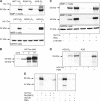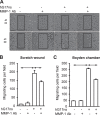Gastrin stimulates MMP-1 expression in gastric epithelial cells: putative role in gastric epithelial cell migration
- PMID: 25977510
- PMCID: PMC4504956
- DOI: 10.1152/ajpgi.00084.2015
Gastrin stimulates MMP-1 expression in gastric epithelial cells: putative role in gastric epithelial cell migration
Abstract
The pyloric antral hormone gastrin plays a role in remodeling of the gastric epithelium, but the specific targets of gastrin that mediate these effects are poorly understood. Glandular epithelial cells of the gastric corpus express matrix metalloproteinase (MMP)-1, which is a potential determinant of tissue remodeling; some of these cells express the CCK-2 receptor at which gastrin acts. We have now examined the hypothesis that gastrin stimulates expression of MMP-1 in the stomach. We determined MMP-1 transcript abundance in gastric mucosal biopsies from Helicobacter pylori negative human subjects with normal gastric mucosal histology, who had a range of serum gastrin concentrations due in part to treatment with proton pump inhibitors (PPI). The effects of gastrin were studied on gastric epithelial AGS-GR cells using Western blot and migration assays. In human subjects with increased serum gastrin due to PPI usage, MMP-1 transcript abundance was increased 2-fold; there was also increased MMP-7 transcript abundance but not MMP-3. In Western blots, gastrin increased proMMP-1 abundance, as well that of a minor band corresponding to active MMP-1, in the media of AGS-GR cells, and the response was mediated by protein kinase C and p42/44 MAP kinase. There was also increased MMP-1 enzyme activity. Gastrin-stimulated AGS-GR cell migration in both scratch wound and Boyden chamber assays was inhibited by MMP-1 immunoneutralization. We conclude that MMP-1 expression is a target of gastrin implicated in mucosal remodeling.
Keywords: MMP-1; gastric epithelium; gastrin.
Copyright © 2015 the American Physiological Society.
Figures






Similar articles
-
Gastrin-stimulated gastric epithelial cell invasion: the role and mechanism of increased matrix metalloproteinase 9 expression.Biochem J. 2002 Aug 1;365(Pt 3):873-9. doi: 10.1042/BJ20020068. Biochem J. 2002. PMID: 11971760 Free PMC article.
-
Increased gastric expression of MMP-7 in hypergastrinemia and significance for epithelial-mesenchymal signaling.Am J Physiol Gastrointest Liver Physiol. 2007 Apr;292(4):G1133-40. doi: 10.1152/ajpgi.00526.2006. Epub 2007 Jan 11. Am J Physiol Gastrointest Liver Physiol. 2007. PMID: 17218472
-
Gastrin regulates the TFF2 promoter through gastrin-responsive cis-acting elements and multiple signaling pathways.Am J Physiol Gastrointest Liver Physiol. 2007 Jun;292(6):G1726-37. doi: 10.1152/ajpgi.00348.2006. Epub 2007 Mar 1. Am J Physiol Gastrointest Liver Physiol. 2007. PMID: 17332476
-
Gastrin and the Moderate Hypergastrinemias.Int J Mol Sci. 2021 Jun 29;22(13):6977. doi: 10.3390/ijms22136977. Int J Mol Sci. 2021. PMID: 34209478 Free PMC article. Review.
-
Gastrin and upper GI cancers.Curr Opin Pharmacol. 2016 Dec;31:31-37. doi: 10.1016/j.coph.2016.08.013. Epub 2016 Aug 31. Curr Opin Pharmacol. 2016. PMID: 27591354 Review.
Cited by
-
Gastrin-induced miR-222 promotes gastric tumor development by suppressing p27kip1.Oncotarget. 2016 Jul 19;7(29):45462-45478. doi: 10.18632/oncotarget.9990. Oncotarget. 2016. PMID: 27323780 Free PMC article.
-
Matrix metalloproteinase (MMP)-7 in Barrett's esophagus and esophageal adenocarcinoma: expression, metabolism, and functional significance.Physiol Rep. 2018 May;6(10):e13683. doi: 10.14814/phy2.13683. Physiol Rep. 2018. PMID: 29845775 Free PMC article.
-
Matrix Metalloproteinases Family Gene Polymorphisms Are Associated with Thrombosis Risk in Myeloproliferative Neoplasms.Int J Mol Sci. 2025 Jul 11;26(14):6646. doi: 10.3390/ijms26146646. Int J Mol Sci. 2025. PMID: 40724896 Free PMC article.
-
Dysregulation of MiR-30a-3p/Gastrin Enhances Tumor Growth and Invasion throughSTAT3/MMP11 Pathway in Gastric Cancer.Onco Targets Ther. 2020 Aug 25;13:8475-8493. doi: 10.2147/OTT.S235022. eCollection 2020. Onco Targets Ther. 2020. PMID: 32922036 Free PMC article.
-
Netazepide Inhibits Expression of Pappalysin 2 in Type 1 Gastric Neuroendocrine Tumors.Cell Mol Gastroenterol Hepatol. 2020;10(1):113-132. doi: 10.1016/j.jcmgh.2020.01.010. Epub 2020 Jan 28. Cell Mol Gastroenterol Hepatol. 2020. PMID: 32004755 Free PMC article. Clinical Trial.
References
-
- Baba M, Itoh K, Tatsuta M. Glycine-extended gastrin induces matrix metalloproteinase-1- and -3-mediated invasion of human colon cancer cells through type I collagen gel and Matrigel. Int J Cancer 111: 23–31, 2004. - PubMed
-
- Black JW, Shankley NP. How does gastrin act to stimulate oxyntic cell secretion. Trends Pharmacol Sci 8: 486–490, 1987.
-
- Bodger K, Ahmed S, Pazmany L, Pritchard DM, Micheal A, Khan AL, Dimaline R, Dockray GJ, Varro A. Altered gastric corpus expression of tissue inhibitors of metalloproteinases in human and murine Helicobacter infection. J Clin Pathol 61: 72–78, 2008. - PubMed
Publication types
MeSH terms
Substances
Grants and funding
LinkOut - more resources
Full Text Sources
Other Literature Sources
Research Materials
Miscellaneous

